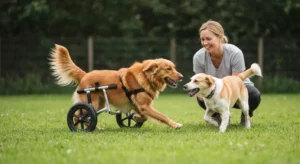July 31, 2025 – In a groundbreaking discovery that deepens our understanding of the human-canine bond, a new study has provided the most definitive evidence to date that dogs can smell the physiological changes associated with human psychological stress. The research, published this month in the prestigious Journal of Comparative Psychology, confirms what many owners have long suspected: our dogs are keenly aware of our emotional state, not just through our body language, but through our very scent.
The large-scale study, conducted by the Canine Olfaction and Behavior Institute at the University of Pennsylvania, successfully trained dogs to discriminate between breath and sweat samples collected from individuals before and after they experienced an acute stressor. The findings move beyond anecdotal evidence, providing a biochemical basis for a dog’s uncanny ability to comfort us in times of distress and react when we are anxious.
The Science Behind the Sniff: How the Study Worked
Researchers have long known that acute psychological stress triggers physiological changes in humans, including alterations in heart rate, blood pressure, and the release of hormones like cortisol and adrenaline. These changes, in turn, affect the volatile organic compounds (VOCs) we release in our breath and sweat. The new study sought to determine if dogs, with their famously powerful noses, could detect these subtle shifts in our chemical signature.
“We wanted to isolate the scent component completely,” explained Dr. Alistair Finch, the study’s lead author and a leading researcher in animal cognition. “Previous observations could always be attributed to dogs reading our posture, tone of voice, or facial expressions. By presenting them only with scent samples in a controlled environment, we eliminated all other cues. The results were astonishing and leave no doubt that there is a distinct ‘smell of stress’ that dogs can identify.”
The methodology was meticulous. The research team recruited 36 human participants who provided baseline samples of their breath and sweat. These same individuals were then subjected to a standardized stress-inducing task: solving a difficult arithmetic problem under intense time pressure and with auditory distractions. Immediately following this task, a second set of breath and sweat samples—the “stress samples”—were collected.
A group of 20 dogs of various breeds, all with a pre-existing aptitude for scent work, were then trained in a discrimination task. Presented with three scent ports, one containing a participant’s stress sample and two containing their non-stress (baseline) samples, the dogs were rewarded for correctly indicating the stress sample. Across more than 700 trials, the dogs correctly identified the stress sample with an average accuracy of 93.8%.
“This level of accuracy is higher than we even anticipated,” Dr. Finch stated in a university press release. “It demonstrates that the physiological response to stress produces a strong and consistent olfactory profile that is easily discernible to the canine nose. It’s a chemical signal, as clear to them as a red light is to us.”
Implications for the Human-Animal Bond
The study’s findings have profound implications for veterinary medicine, animal behavior, and the everyday lives of pet owners. Experts believe this new understanding of human stress detection in canines can help us better interpret their behavior and strengthen our relationships with them.
Dr. Lena Petrova, a board-certified veterinary behaviorist not affiliated with the study, commented on its significance. “This is a pivotal piece of research. In my practice, I frequently see cases of ‘referred anxiety,’ where an anxious owner has a dog with significant behavioral issues. We often counsel owners that their emotional state impacts their pet, but this study provides the biological mechanism. The dog isn’t just mirroring behavior; it’s reacting to a distinct and potentially alarming scent cue.”
This phenomenon, Dr. Petrova explains, can create a feedback loop. An owner feels stressed, their dog smells it and becomes anxious, which in turn makes the owner more stressed about their dog’s behavior. “Understanding that a scent is at the core of this interaction allows us to develop more effective and empathetic management strategies,” she added.
Professional dog trainers also see the study as a game-changer, particularly for addressing reactivity and anxiety in training sessions. Marcus Thorne, a certified canine training and behavior specialist with over two decades of experience, notes, “When a client is struggling to train their dog, frustration is common. What this study tells us is that the moment you get frustrated, your dog knows it on a chemical level. It smells your stress, which can cause it to shut down, become fearful, or act out. It’s not being stubborn; it’s reacting to an invisible but powerful signal of distress from its leader.”
What This Means for You and Your Dog: An Expert-Backed Action Plan
The news that your dog can literally smell your stress might feel like added pressure, but experts say it should be empowering. This scientific insight into your dog’s sensory world gives you a powerful new toolkit for building a healthier, more harmonious relationship. It’s not about hiding your stress, but about managing it mindfully for the benefit of both you and your loyal companion.
Here is a comprehensive guide, based on expert advice, to translate this new science into positive action.
-
1. Practice Mindful Self-Awareness: Your Stress Has a Scent
The first and most crucial step is to acknowledge the biological reality: your stress is not just a mental or emotional experience. It’s a physical event that produces a tangible scent. The study confirms your dog is a living, breathing barometer of your inner state. Instead of feeling guilty about this, use it as a prompt for self-awareness.
Actionable Tip: Set a few quiet alarms on your phone throughout the day. When one goes off, take 30 seconds to do a “stress check-in.” Are your shoulders tense? Is your jaw clenched? Is your breathing shallow? Simply noticing is the first step. By becoming more aware of when you are emitting these “stress VOCs,” you can become more intentional in your interactions with your dog during those times.
-
2. Create a “Co-Regulation” Ritual for Stressful Moments
Since your dog will detect your stress, the goal is not to prevent the detection but to manage the response—both yours and theirs. A co-regulation ritual is a pre-planned, simple routine you initiate the moment you feel stressed. This creates a new, positive association for your dog, turning an alarming scent into a cue for a calm, connecting activity.
Actionable Tip: Design a 5-minute “stress-break” routine. When you feel overwhelmed, say a gentle cue word like “Let’s breathe,” and immediately engage in a calming activity together. This could be:
- Slow, Rhythmic Petting: Sit on the floor with your dog and use long, slow strokes down their back. This is proven to lower cortisol in both humans and dogs.
- Shared Deep Breaths: Step outside into fresh air together. Take five slow, deep breaths, audibly exhaling. Your dog will pick up on the change in your rhythm.
- A “Scent Game”: Redirect both of your minds by tossing a few high-value treats into the grass and telling your dog to “Find it!” This engages their primary sense in a positive way and provides a welcome distraction for you.
-
3. Re-evaluate High-Anxiety Situations Like Vet Visits and Training
Certain situations are notorious for causing owner anxiety, which can sabotage the intended outcome. Using the knowledge from this study, you can proactively manage your scent signature to set your dog up for success.
For Vet Visits: Your anxiety about your dog’s health or behavior at the vet is a potent stress signal. Before you even get in the car, your dog may already smell your worry.
Actionable Tip: Before a vet appointment, spend 10 minutes doing a calming activity completely unrelated to the visit. Play a gentle game or practice the co-regulation ritual mentioned above. Speak to your vet about “happy visits” where you just pop in for a treat and leave, building positive associations. Your calm state is the most powerful calming tool you have.For Training Sessions: As trainer Marcus Thorne noted, frustration is the enemy of effective training. The moment your dog smells your stress, its ability to learn plummets.
Actionable Tip: Keep training sessions short (5-10 minutes max). Focus on one simple skill. If you feel yourself getting tense or frustrated, stop immediately. End the session on a positive note by asking your dog for a behavior it knows well (like “sit”) and rewarding it enthusiastically. Come back to the more difficult skill later when you are calm and reset. -
4. Reinterpret Your Dog’s “Stress Response” Behaviors
When a dog smells its owner’s stress, it often displays behaviors that can be misinterpreted as naughtiness or disobedience. Dr. Petrova calls these “appeasement behaviors” or signs of anxiety.
Common Stress Responses in Dogs:
- Excessive yawning when not tired
- Frantic lip-licking
- Pacing or inability to settle
- Becoming unusually “clingy” or, conversely, distant
- Low-level whining or grumbling
- Sudden distraction or “sniffing the ground” to avoid a task
Actionable Tip: When you see these behaviors, don’t correct your dog. Instead, use it as a cue to check in with yourself. Ask: “Am I feeling stressed right now?” View your dog’s behavior not as a problem, but as a communication. They are telling you, “I smell that something is wrong, and it’s making me uncomfortable.” This shift in perspective from judgment to empathy is fundamental. Thank them for the signal and initiate your co-regulation ritual.
-
5. Build Your Dog’s Emotional Resilience Independently
A confident, well-adjusted dog is better equipped to handle external stressors, including the scent of your anxiety. While a nervous dog might absorb your stress like a sponge, a resilient dog is more likely to process the signal without becoming overwhelmed. Building their confidence is a gift to both of you.
Actionable Tip: Focus on confidence-building activities that don’t depend on your emotional state.
- Nose Work: This is the ultimate confidence-builder that directly plays on the skills highlighted in the study. Hide treats or scented toys around the house and let your dog’s powerful nose lead the way. Successfully finding a “prize” is a huge ego boost.
- Puzzle Toys: Food puzzles require your dog to problem-solve independently, building self-efficacy.
- Trick Training: Learning new, fun tricks in a positive environment builds a dog’s sense of accomplishment and strengthens your bond.
-
6. Know When to Create Healthy Separation
There are times when your stress is intense and prolonged, such as during a high-stakes work project, a difficult family matter, or a period of grief. In these situations, constantly exposing your dog to your stress scent can be detrimental to their well-being.
Actionable Tip: It is okay—and sometimes necessary—to create a loving, managed separation. This is not a punishment. If you know you’re facing a few hours of intense stress, give your dog a high-value, long-lasting chew (like a frozen Kong) in a separate, quiet room with some calming music playing. This proactively protects them from a constant bath of stress chemicals. It allows you to handle what you need to handle without worrying that you are negatively impacting your best friend, making it a compassionate choice for you both.
Ultimately, this landmark study on human stress detection doesn’t add a new burden to pet ownership. Instead, it illuminates the incredible depth of the connection we share with our dogs and provides a roadmap for how we can be better, more mindful partners to them—in sickness and in health, in calmness and in stress.












